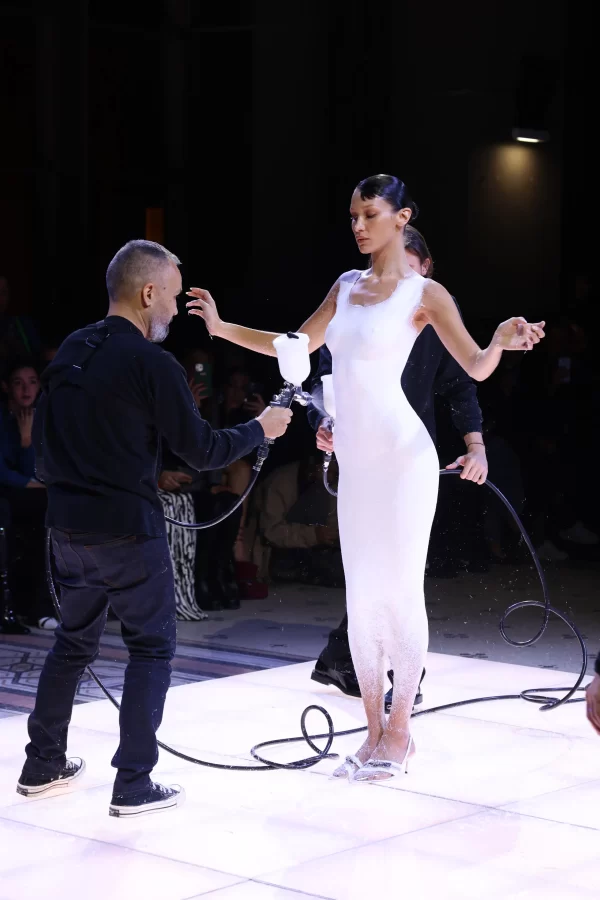Couture in a Can
Supermodel Bella Hadid at Coperni SS23.
Probably the most viral and puzzling video of spring-summer 23 fashion was the slender figure of none other than supermodel Bella Hadid at Paris Fashion Week, strutting down a runway in Coperni’s show wearing… a plain, off-the-shoulder white dress.
At first glance, it’s nothing special. Of course, it would amass millions of views. The performance offered an ultra-famous supermodel in Paris and none other than Kylie Jenner sitting in the audience- some of the internet’s favourite things.
But rewind the video 2 minutes, and you’ll notice a bare Bella, surrounded by designers holding aerosols as the dress appears quite literally out of thin air.
A spray-on dress. Not only was the idea fascinating, but the results were genuinely impressive. A glossy, sleek looking fabric that one would never have expected to come from a can.
So, as a resident materials chemistry and fashion geek™, I had to do some digging. And although this whimsical garment reminds me of Flint Lockwood’s spray-on shoes à la Cloudy With a Chance of Meatballs, there is some pretty credible science behind this.
The dress, made from a patented spray-on material named Fabrican, is a mixture of liquid natural and synthetic polymers suspended in a diluent. This diluent is typically an organic solvent like acetone or water. When pushed through an aerosol, the solvent evaporates when on the skin and the polymers bind, creating a sponge-like surface.
To translate, think of spider webs or silly strings: two of the inspirations of the creator, materials-scientist-turned-fashion-designer Manel Torres. He received scientific backing for this technology from Imperial College London in 2003 and has been perfecting it since.
This isn’t the first time a runway has seen technology of this kind: For his spring 1999 show, Alexander McQueen had two robots spray-paint a dress worn by model Shalom Harlow. Even at the Coperni show this year, Hadid wasn’t the only model to be adorned with the alien material: Mona Tougaard wore a spray-on tank top as well.
Without going all ROTIOS on you (sorry in advance), I’d like to make the case that spray-on fabric isn’t garbage. Whether it looks sexy or not aside, the concept behind it is revolutionary: it makes the tedious procedure of fitting, sourcing fabric, repairing holes, and taking measurements quick and easy. The garments produced are seamless. Contrary to popular belief, the material isn’t rigid like latex, and is surprisingly pliable while remaining sturdy, similar to suede. And, although it carries a strong glue-like odour, it is nontoxic to the model spray-ee.
It’s almost impossible to not be a bit sceptical of futuristic fashion. For one, the dress isn’t strictly sellable and can’t be reworn by anyone without Bella Hadid’s proportions (so, nobody). Its sustainability can even be challenged- aerosols as a delivery system are likely the least efficient or practical- generating heaps of waste in the process.
But the dress can be taken off, washed, or even put back into the bottle of solvent to dissolve and be sprayed on again, according to Coperni’s chief executive, Arnaud Vaillant.
If anything, it shifts mindset from buying clothing to using clothing- a circular consumption concept that fashion may need to adopt going forward.
Although it was definitely theatrical on the Coperni runway, Fabrican isn’t just for show- the company is investigating other important applications of spray-on fabric, like medical casts, bandages and sanitary pads. Considering only a few months ago mainstream media could never dream of this magical creation, it could very well progress and evolve into something practical or marketable within a few years from now.
While the Coperni science-art fusion this year was wonderful to witness, it marks a pivotal moment for the future of fashion. It’s still crucial, however, to challenge how sustainable or applicable Fabrican really is before introducing it to your daily wardrobe.
And then, who knows? ISL’s 3022 dress code may have to cover up loose midriffs (god forbid) with aerosol fabric, or spray over your open-toed shoes in science class. The possibilities just seem to appear out of thin air.

I’m a year 13 student who loves chemistry and poetry! I love writing about STEM, and I’m looking forward to writing more opinion articles and current...





